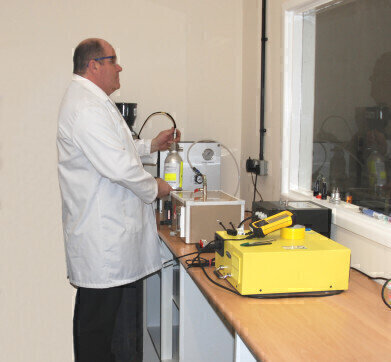Health & safety
Analyser Helps Protect Safety of Diving Gas
Jun 26 2012
An advanced multiparameter gas analysis technology (FTIR) from Quantitech (UK) is being employed by Case Chemicals to analyse diving gas for recreational, commercial and military divers. According to Case’s Sam Wray, “This technology provides much higher levels of confidence than traditional techniques, partly because it is highly accurate and also because FTIR can detect almost any gas or vapour.”
In addition to the supply of chemicals, Case also provides analytical services for a wide variety of applications including occupational exposure, legionella, asbestos, contaminated land, waste acceptance, industrial emissions and breathing gases.
The quality of diving gas is protected by routine analysis of sample bottles taken from the compressors that generate compressed air. The Health & Safety Executive (HSE) requires samples of air supplied for breathing apparatus to be tested at least once every three months and more frequent tests would be necessary if contamination is foreseeable within this three month period.
The standard BS EN 12021 requires that all contaminants should be kept to as low a level as possible and shall be not greater than 10% of the UK 8hour time weighted average exposure limits which are specified in the HSE publication EH40.
The FTIR analyser employed by Case Chemicals was supplied by Quantitech’s Dr Andrew Hobson who pre-configured the analyser (a Gasmet DX4030) to measure a wide range of parameters including CO, CO2, hydrocarbons, NH3, HCl, HF, NO2, N2O, SO2 and a range of halocarbons such as Freon. This configuration was established to meet and exceed the requirements of both BS EN 12021 and the military standard DEF STAN 68-284.
Commenting on the benefits of FTIR, Sam Wray says, “In the past, some of our clients have used chemical stain tubes which can have an error of up to 30%, so whilst these are individually cheap, they are highly inaccurate in comparison with FTIR. The tubes also only test for an individual parameter, so they are incapable of detecting any contamination other than the parameter on test.”
Highlighting the importance of being able to detect a very wide range of chemicals, Sam refers to a sample of gas that was supplied by a leisure diving company in the Middle East. “FTIR analysis revealed an unacceptable level of formaldehyde which was traced to a cleaner that was being used on-board the ship – without this analytical technique it is unlikely that the formaldehyde would ever have been detected,” he says.
Although the DX4030 is a portable FTIR analyser, Case Chemicals have it permanently located in one of their laboratories and Sam says “It has been extremely simple to operate; calibration is merely a quick zero check in the morning. We are therefore looking to exploit the flexibility of FTIR in other markets – for example, we are planning to offer FTIR analysis for other forms of compressed air, occupational health investigations, contaminated land and even anaesthetic gases.”
Digital Edition
AET 28.4 Oct/Nov 2024
November 2024
Gas Detection - Go from lagging to leading: why investment in gas detection makes sense Air Monitoring - Swirl and vortex meters will aid green hydrogen production - Beyond the Stack: Emi...
View all digital editions
Events
Jan 12 2025 Abu Dhabi, UAE
Jan 14 2025 Abu Dhabi, UAE
Jan 20 2025 San Diego, CA, USA
Carrefour des Gestions Locales de L'eau
Jan 22 2025 Rennes, France
Safety, Health & Wellbeing LIVE
Jan 22 2025 Manchester, UK



















